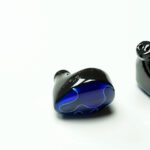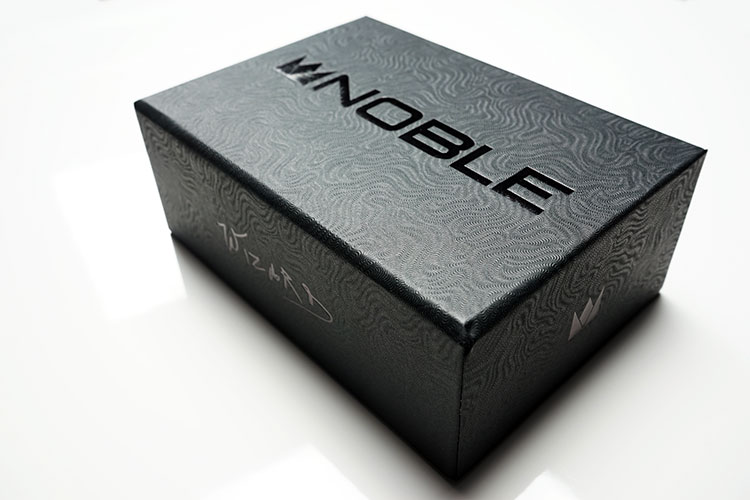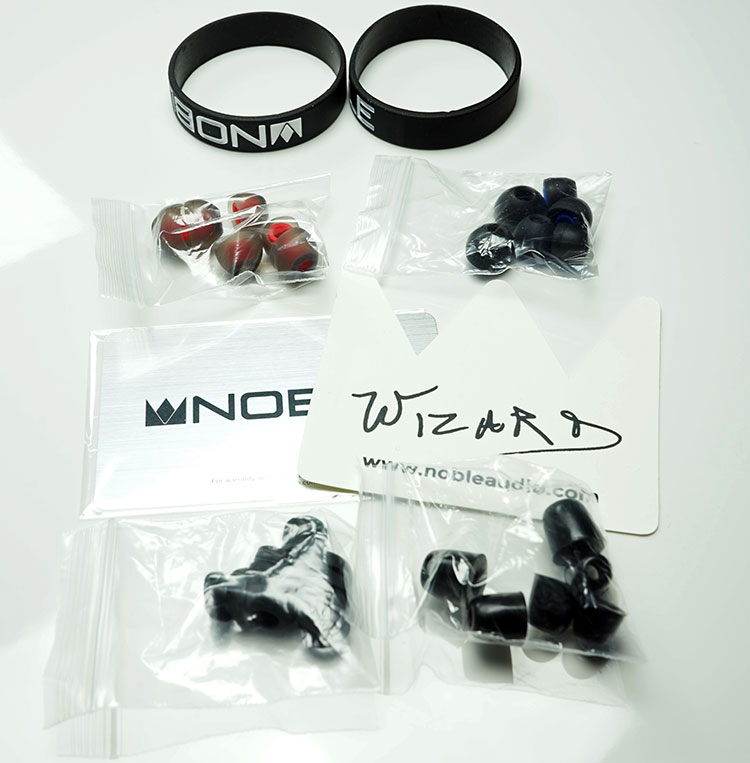Today, we review the Noble Audio Savant Wizard Edition which is a hand-crafted universal IEM using two balanced armature drivers. It is priced at $599.
Disclaimer: This is a sample sent to us in exchange for our honest opinion. Headfonics is an independent website with no affiliate links or status. We thank Noble Audio for their support.
To read more about Noble Audio products we have previously featured on Headfonics click here.
Note, that this article follows our latest scoring guidelines which you can read up on here.
In French, the term “savant” is derived from the French term ’savoir’ or “to know” in English and is generally interpreted to mean “knowing” or knowing a lot about a particular subject.
Given that Noble’s Savant line is highly secretive about how many actual drivers are stuffed into their all-new Wizard Savant line I thought the term was rather apt – The Wizard knows – but no one else.
Now I am sure this base $599 new BA IEM from Noble will be eventually cracked open to reveal what is inside and the matter will be put to rest but that won’t be me in this review I assure you.
Instead, I will go with the flow, probably guess a bit wrong because cracking open an IEM as sleek as this one is just plain wrong.
My last encounter with a Noble IEM was the Classic 4 line and I thought it a perfect reviewers tool, a reference IEM sounding flat, neutral and though devoid of musicality could more than adequately display excellent detail and balance to wire right into the sound of something else like a DAP or amp. So when Noble said, ‘hey try out the new Savant universal line’, I couldn’t resist.
What Do You Get?
This time Noble has decided to upgrade the packaging experience, particularly with the boxes both inside and out. Gone are the rather drab colored sleeve from the Classic 4 line and in comes and more integrated black box design with the logo clear and center on the top of the lid and “Wizard” to the side. Much better this time.
Open it up and the next change is the move from the smaller Otter Box type hard cases from the Classic 4 line and onto a much deeper and more elegant black Pelican 1010 case which offers a heck of a lot more room for your IEMs than before.
Alongside the unit itself inside the 1010 case, you also get an ear-cleaning pick. a soft velvet cloth pouch should you wish to ditch the larger hard case and a plethora of differing tips, a few rubber straps, a warranty card, and a few Noble stickers.
The selection of tips is excellent actually and I am pretty sure at least one type of material or size will fit your needs. I grabbed the smaller of the two double flange tips as my preferred option due to comfort and seal and as such the review is done with those in mind. For everyone else if these don’t suit you can try the following:
- 1 set of hybrid red stem single bore silicone tips in small, medium, and large
- 1 set of hybrid blue stem single bore tips in small, medium, and large (differs with a slightly softer material to the red stem)
- 1 set of dual flange silicone tips in small, medium, and large
- 1 set of foam tips in small, medium, and large
Design
These guys build great customs and it’s no surprise that the Savant, even in a universal form, also has that same great build quality. Made from hardened plastics, the Savant has a medium to small-sized form factor similar to the Classic 4 but just a tiny bit smaller and with a much smoother finish (the colored lot editions come in at $799).
The standard edition is pretty much the same understated uniform black design of the Classic 4 with three slate pentalobe screws on a prominent display to create more of an industrial feel than anything else.
Standard edition Savants also have a slightly raised bevel logo on the front plate whereas the Wizard Savants have a glossy-colored and smooth face plate finish without the logo imprint.
You can get the finishes in a number of different colors such as blue, yellow, etc but I am not sure it’s going to be consistently the same colors. There may be room for experimentation that trickles down into the Wizard Savant range from the CIEMs later on.
The unit is a detachable unit with a traditional Westone style 2-prong connector and we do know it’s a BA setup since the unit seems to lack any sort of bass port on the shell.
Comfort & Fit
One of the better ones out there in the market in terms of a comfortable fit and superior isolation for a universal IEM. The techniques and know-how from the customs business stand Noble in good stead as it slots right in and no messing about.
Yes, the tips will play a role in the fit and for me, the double flange gave the best balance in terms of seal and comfort and was just behind the medium single-bore red stem single tips.
Isolation was excellent with minimal leakage and background noise creeping in. The over-the-ear fitting and noise cancellation were superior to all but the Westone series and produced better results than the RHA T series, the UE900, and even the IE800.
Cables
The Noble Wizard Savant utilizes a Westone 2-pin socket connection and looking at the cable it seems much the same as the stock cable from the Classic line and possibly from their CIEM line.
The stock cable itself is a very pliable and flexible light over-the-ear cable with matching colored memory tubing for steadying the unit around your ear and reducing microphonics to a minimum.
The cable is a 4 cable braided construct with individual plastic wrapping with a rather basic plastic ‘y split’ tube and a second short tube for chin locking.
It all works, microphonics are to a minimum, memory retention is zero and it’s really comfortable to wear and light and soft enough to manipulate with ease. Cable swappers should feel right at home with the Wizard Savant.
Sound Impressions
Summary
Noble have gone with something a little bit more musical and fun sounding with the Wizard Savant over the Classic 4. This is not as neutral or flat and therefore unlikely to sound as “reference” as the Classic 4.
The Wizard Savant trades absolute analytical correctness for something a bit smoother, a bit more flowing, and a bit easier on the ear but no less competent in detail retrieval and resolution.
I would not term the tonality colored though, it still has definite audiophile sensibilities, but this time it sounds very natural and with a slight edge taken off, especially at the top end which didn’t sound as dry as the Classic 4 but just as clean. The Wizard Savant reminds me a lot of the junior version of the A12T from 64Audio which retails about 4 times the price.
If you are looking for something more genre agnostic, then the Wizard Savant makes a very good claim indeed. It’s an earphone with a very likable timbre, great extension, and just enough smoothness to prevent fatigue after long listening periods.
Bass
The Wizard Savant has a slightly elevated bass response, particularly around the 50-100hz range before tapering off a little from 30hz downwards.
The bass extension is somewhat more convincing than the Classic 4 and certainly is not as flat or neutral with a hint of warmth and more presence than the Classic. The resulting response is impactful and more musical but it’s not exaggerated or slow.
Having said that I didn’t find the Savant bass as fast or clinical as the Classic 4 which had a tighter and cleaner low end.
Sub bass on the Wizard Savant is good but not dominating with a slight roll-off right at the bottom, the main punch comes from that 50-100hz area so EDM and hard rock will benefit most from the Savant’s richer bass line and orchestral sub bass drum work might lose out.
It is horses for courses really between the two and as before I felt the Classic 4 couldn’t deliver the bass vibe and feel of modern rock and pop the Savant really can.
Mids
Tonally the Savant mid-range is smooth and spacious sounding though slightly recessed in the lower mids but not by much.
The mids on the Wizard Savant are designed to give a bit of a platform to vocals, perhaps more so with female vocals over lower-pitched male vocals. It doesn’t possess any huge peaks, more of a drop off in the lower mids until around 1-2k with a smooth elevation until 3k before falling away again in the top end.
Though smooth sounding I didn’t find the mid-range to be that full-bodied, thick or lush. It lacked a little low-end presence making notes seem a tiny bit thinner than they needed to be. The trade-off seemed to be more of a focus on excellent detail, separation, and clarity over something too rich or full sounding.
That being said instrumental separation is excellent and very well controlled never once sounding congested. Paquito D’Rivera’s stunning clarinet chops in “Tu” were inch-perfect in both speed and clarity. You couldn’t really ask for more in that department.
The vocal performance on the Wizard Savant is very good, particularly with female vocals. I am a big vocal lover and the Savant didn’t let me down in this department in terms of control and sibilance-free performance. Dash Berlin’s “Like Spinning Plates” female solo vocal was pitch-perfect, smooth, and sibilant-free.
Treble
The treble on the Savant aims for extension and clarity with a purposeful dip in the lower treble that subdues any nasty sibilance and keeps percussion works slightly in the background.
Noble has opted to put the sparkle in the Savant just a little bit higher at the 10k range rather than the 5-7k range which is hugely welcome. 7k peaks are awfully challenging to match with source and amps and often distract unnecessarily especially sounding splashy if not done correctly.
With a subtle peak at 10k, Noble is able to tune the Savant to sound clean and clear with good extension but avoiding any unwanted sharpness to produce a very nonfatiguing treble performance that still has plenty of sparkle.
Post 10k things begin to fall away sharply so you do not get an extreme extension but only the treble purists would notice something like that. Personally, this is the kind of treble I tend to enjoy especially with genres that need a good treble detail as trance or prog rock works like Pink Floyd where I find there is a lot of subtle detail that needs a good focus on clarity.
Sound Stage & Imaging
The Wizard Savant is a lovely compromise between being expansive and accurate. The width is just wide enough to sound realistic without being too left/right and the staging overall sounds bigger and more hall-like compared to the more intimate Classic 4 sound stage.
Separation is spacious and with good placement and very accurate imaging and whilst there is not a huge amount of depth or extension I think there is just enough to convey a very believable “3rd row” in the audience-type experience. In all a very coherent presentation.
Synergy
The Wizard Savant is rated at <30 ohms so it is unclear how much below 30 ohms it is rated at or if it is indeed right on 30 ohms. An educated guess might place it at around 26-30 ohms with around 106- 116db but it is entirely debatable given the lack of specs Noble is yielding for the Savant.
At no point on any of the DAPs, I tested did I detect any unwanted noise or background hiss with the Savant.
Low-End Sources
That being said it’s a relatively easy IEM to drive out of most sources including smartphones. I had no issues at all with the BB Passport which I regard as my best smartphone but overall my weakest amp and source.
Volume on the BB Passport topped out at 7.5/8 and somewhere in the same range as my Westone 4 quad BA and ever so slightly less efficient than the Cypher Labs C6IEM V1 by half a bar of volume. The C6IEM is rated at 26 ohms so that slight increase in efficiency probably places the Savant closer to the 30-ohm mark.
I have to say on the budget side of things full marks also for the FiiO M3. Paired with the Savant made for a very easygoing and pleasurable listening pleasure.
That slightly richer weighted tone of the M3 paired very well with the crystal clear natural tones of the Savant. Nothing peaky, too thin, or sibilant with volume at less than 50%. Sure it’s not the last word in resolution or dynamics but it is more than acceptable for a budget source.
Mid to High-End Sources
Higher up the food chain and the Savant sounded excellent with clean and clear DAPs such as the X7 with a gain output sitting very comfortably at 65 on the X7’s digital volume control and around 65-70 on the warmer-sounding DX80 from Ibasso.
Generally speaking, the Savant sound is a more flexible sound for DAP matching than the Classic 4. That natural flowing signature lends itself very well to DAP from the FiiO X5ii right up to the AK380. I couldn’t really find a DAP that made it too sharp or harsh.
If there is one area that I felt might be something people will want to tinker with is the general richness of the mid-range. Stock on the AK240 might leave a few people wanting for a bit more body but then that’s a common theme for the AK240 regardless of its outstanding accuracy.
If your DAP has an EQ you might want to fiddle around with that for the desired effect or pick an inherently warmer or richer amp such as the Vorzamp Duo or the Cypher Labs Picollo.
Our Verdict
Who is a clever little Wizard then? If the Classic 4 was all about neutrality for pure reference with detail, then the Savant is all about that same level of detail in a slightly more musical package that audiophiles can enjoy without shouting “colored”.
The slight thinness of the lower mid-range stops me from awarding supreme marks but I have to say I really enjoyed the natural tonality of the Savant and its ability to produce a detailed yet fatigue-free listening experience.
It’s also a much more flexible IEM than the Classic 4 for genre matching and DAP matching as a result of that engaging sound. You will rarely get a complaint for me on this IEM on just about any DAP you can throw at it, or smartphone for that matter.
Those looking for a healthy dollop of sub-bass won’t find it here, this is not an exaggerated bass response. It is much more coherent with the rest of the range than that but there is just enough mid-bass lift to give it a nice injection of welcome warmth where the Classic 4 went missing in action.
Noble Audio Savant Wizard Edition Specifications
- Impedance < 30
- Detachable cable w/ industry-standard two-pin configuration
- Signature Noble universal form factor
- Wizard-signature on the right shell







